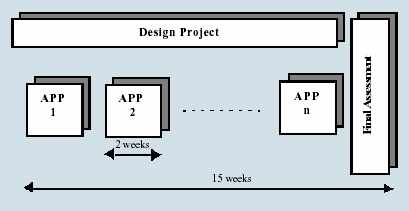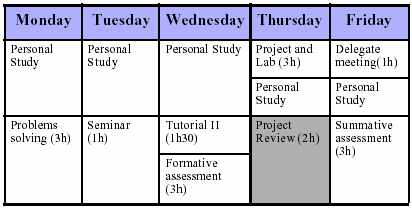
by Gérard Lachiver, Daniel Dalle, Noël Boutin, André Clavet,
François Michaud, Jean-Marie Dirand,
Département de génie électrique et de génie informatique,
Université de Sherbrooke, Sherbrooke, QC
1.0 Introduction
The engineering profession is going through exceptional change. It requires an increasingly broad range of skills and know-how to solve increasingly complex problems in a rapidly changing economic environment. Companies are looking for engineers with a harmonious balance of sophisticated technical competencies and refined intra- and interpersonal skills in communication, teamwork, management, creativity, social responsibility, and sensitivity to ethics and sustainable development. Several Canadian and American studies have identified serious gaps between the objectives of engineering programs and the needs of an economy in full transformation [1].
| In fact, students perceive engineering as difficult and very demanding. |
Three years ago, the Department of Electrical and Computer Engineering of the Université de Sherbrooke reviewed its Bachelor Engineering degrees. While graduates have a 100% employment rate and employers have a deep appreciation of graduates' technical knowledge, some conclusions drew our attention. Students start their engineering study with curiosity and enthusiasm. They are eager design products, to build systems, and to work on real engineering projects. However, the first year comprises mainly courses in fundamental sciences and mathematics, which, although essential, offer little contextualization with real engineering problems. In fact, students perceive engineering as difficult and very demanding. A detailed analysis revealed that the programs consist of a succession of courses that students must work through one after the other. This structure leads students to compartmentalize concepts and fails to facilitate their use later courses. In fact, students rarely have to integrate material from more than one subject to solve an engineering problem as it really appears. This fragmentation of the corpus of knowledge favors superficial learning limited in space and time. It is thus necessary to repeat given concept several times whenever it is needed. Finally, we noticed that the design process, hallmark of engineering, is especially concentrated in the program's final year as a capstone design project, but that significant dimensions such as multidisciplinarity, ethics, and social and economic aspects were underrepresented.
Determined to improve undergraduate engineering education, the Department of Electrical and Computer Engineering of the Université de Sherbrooke undertook a major redesign of its programs and adopted a new learning paradigm that will have fundamental and long-lasting impact on the quality of its graduates. This ambitious and innovative reform reconstructs all of our current engineering education practices and takes careful consideration of the many elements affecting the quality of engineering education. To achieve this large-scale endeavor, we defined two structuring frameworks. The first specifies the outcomes the students should be able to demonstrate upon completion of their studies, that is the competency-based structure. The second-the learning framework- is based on recent research in learning theory and provides for the detailed design of all educational activities and the development of an effective assessment scheme.
This paper presents a general overview of the main characteristics of these frameworks and presents some key steps leading to implementation of these new programs.
2.0 Curricula Framework
“Conventional” engineering programs give priority primarily to knowledge acquisition. In doing so, they neglect not only the process of personal and social construction of knowledge, but also the development of professional competencies. While not completely ignoring competencies, they focus on allowing students to develop a deep knowledge base before they are able to think about applications and their integration in competence. Electrical engineering and computer engineering programs at the Université de Sherbrooke reverse this procedure by putting the gradual development of the professional skills students need to remain in the foreground of training. Competence can be defined as a complex ability to act founded on the effective mobilization and use of a set of resources. The central idea of this ability to act brings out that each competence is embodied in action and that it allows an individual to implement a set of reflections, processes, strategies, and actions to solve a given task. The ability to act helps distinguish competence from a simple procedure, which distinguishes competence from becoming synonymous with know-how. The ability to act thereby invests competence a comprehensive role and character. From this perspective, a curriculum can contain only a limited number of competencies, each of them integrating a very high number of resources. In addition, ideas of mobilization and use are capital because a competence does not constitute a kind of algorithm memorized and practiced repeatedly in order to ensure its perpetuity and reproducibility. An ability to act is very flexible and adaptable to different contexts and various problems. This flexibility and adaptability justify the importance of the mobilization. A competence concerns heuristics more than an algorithm. Many and varied resources are required when implementing a competence, with knowledge constituting a very significant part of these resources. While referring to the cognitive resources, authors emphasized the fact that a competence is a system of knowledge that is declarative (know factual information), conditional (know how to use the knowledge in specific ways), and procedural (know when and where to apply this knowledge) that is organized in operating plans that allow, within a family of situations, problems to be identified and solved through effective action. This second definition, complementary to the first, brings out that knowledge is an indispensable resource for competencies and, consequently, it should occupy a very important place in a competency-based engineering curriculum.
A competency-based curriculum, also referred to as outcome-based education, specifies the outcomes students should be able to demonstrate upon completion of their studies and orients educational practice towards ensuring that students achieve those outcomes. That is, instead of determining whether students graduate based solely on the number of accumulated credits, graduation would be contingent upon demonstrating mastery of a defined set of competencies [2]. Designing a competency-based program is a top-down process. The first and most important step is to identify the competencies that each student should be able to demonstrate upon graduation, that is, those expected from an engineer at the start of his or her professional career. The second stage is designing a curriculum map. This tool assigns the final competencies of each session of the program in order to ensure a gradual and controlled development of each competence throughout the curriculum. The last stage is the specific design of specific learning activities to acquire these kinds of knowledge and skills. Each activity must describe:
- The competencies it addresses and the mastery level,
- The learning context most suited for the development and expression of the competence (course, tutorial, project, teamwork, individual reading), and
- The mechanisms and criteria required to assess each competence.
In practice, engineering competencies have a holistic meaning but, for the purpose of our programs, competencies are classified in four main categories:
- Electrical engineering scientific and technical competencies,
- Design competencies,
- Interpersonal competencies,
- Intrapersonal competencies.
Examples of Key Competencies:
- Solve complex electrical-engineering problems in the field of signals and systems, analog and digital electronics, electrical energy, automatic control, and communications,
- Plan and manage engineering project,
- Work effectively on disciplinary and multidisciplinary teams in varied contexts,
- Exercise capacities of analysis, abstraction, synthesis, and creativity.
3.0 Learning Paradigm
Competency-based education is grounded on cognitive sciences, in particular, the constructivist philosophy of teaching and learning. Our electrical engineering and computer engineering programs have been designed according to this theory. Each student learns through a personal construction of knowledge and competence that progressively leads him or her to become an independent, self-governed learner. The learning framework is based on fundamental principles suitable to competency- based education [4]:
- The first is that any learning requires the support of previous knowledge and conceptions,
- A second principle stipulates that the hierarchical organization of knowledge plays a very important role in the professionalization of students. It is crucial, in learning, that students connect pieces of knowledge, that they determine hierarchical relationships, and that they recognize the professional situations in which this knowledge should be applied,
- The third principle emphasizes the fact that learning viability requires strong initial contextualization. It is of prime importance that learning be based on complex situations that yield meaning,
- A fourth principle stipulates that transferability of learning be supported by actions of decontextualization and recontextualization. Consequently, it is important for students to regularly reuse their newly acquired knowledge in contexts that are different from the initiating contexts and that students be guided and supervised in their first attempts at recontextualization. Considering that learning instances are not isolated entities but rather constitute resources for comprehension and action,
- The fifth principle emphasizes the fact that the new learning instances should be built to closely connect with cognitive strategies (How to judiciously use knowledge and skills? How to put them into action?) and metacognitive strategies (How to self-regulate the implementation of cognitive strategies, knowledge, and skills?).
|
Le terme “contextualization” est un terme technique courant des sciences
de l'éducation utilisé pour décrire le processus d'enseignement et
d'apprentissage.
The term “contextualization” is a technical term used in educational sciences for explaining the processes of teaching and learning. |
4.0 The Program
A competency-based curriculum requires a new pedagogical approach. It appeared almost impossible to preserve a curriculum that gave priority to quite distinct activities such as lectures and laboratories, which stress adding knowledge rather than integrating it into competencies. All things considered, it was a question of privileging a curricular structure that directly supports the personal and social construction process of the knowledge and competencies required to intelligently practice engineering. Given the principles stated above, the revised programs were designed with a composite approach of project and problem-based learning referred as APPI (French acronym for Apprentissage par Problèmes et par Projets en Ingénierie, which can be translated as project- and problem-based learning in engineering). These cooperative programs last eight academic semesters, alternating with four internships beginning after the third semester. Each semester is organized around a theme (i.e., signals and systems, computer architecture, electrical systems, etc.) and basically includes two types of activities: several twoweek, problem-based learning units and a design project, which extends over the entire session (Figure 1). The project is worth 3 credits the first year and 9 credits the fourth year, for semesters of 15 credits. So, during the curricula, the focus on solving problems decreases to give more liberty to students to apply their competencies to projects. A faculty team is in charge of all activities during a given semester.

Our curricula are built on problembased learning (PBL). They are organized around problem scenarios rather than disciplines or subjects as in a traditional program. PBL is also the principal mode of knowledge acquisition. Each problem is formulated so that the solving process leads students to discover what of their existing knowledge can be used, what they need to learn, and what skills are required to manage the situation effectively.
This learning contextualization provides for better knowledge organization, ensuring the recall and application of that information in subsequent situations. It provides realistic applications and the portability of skills across experiences, while increasing relevance for learners. PBL facilitates the learning paradigm shift from passive to active learning. It encourages students to take more responsibility for their own learning. This means that professors, after the beginning of the program, should not provide information that they feel is required by students in their studies, nor suggest reading or study assignments.
According to this paradigm, students must learn to determine what they need to learn, based on what they already know, and seek out suitable learning resources. Professors become “resources”, coaches, or tutors. In our programs, PBL takes place in small groups (typically comprising 12 students) within a tutorial setting. Under tutor guidance, students gradually develop their self-study skills, which is absolutely essential in a profession in which new problem types and new information grow at a frantic pace. Problem construction requires a particular attention. Problems must issue from real engineering situations and allow students to access, study, and integrate information from different disciplines. Problems must be designed to reinforce the learning process rather than ensure total coverage of knowledge. At the end of each PBL unit, students should reflect on what they have learned in terms of concepts and principles, and determine if anything is missing in their understanding of the problem. This important stage allows students to translate procedural knowledge acquired during problem solving into declarative knowledge for reuse in other problems. Concept maps are very useful tools in this process. Student collaboration is also an important characteristic of PBL. Naturally occurring during group discussions with the tutor, it facilitates individual learning and develops teamwork skills, which are essential for engineers. Tables 1 and 2 show the typical organization of a PBL unit (grey zones are related to project activities).


A PBL unit starts with a tutorial meeting, which has a structure, adapted from [4]. During a tutorial, students:
a) explore the problem and identify issues;
b) formulate “what the problem is”;
c) identify pertinent knowledge acquired previously;
d) identify what is not known and what new information is needed; and
e) as a group, prioritize the learning needs, and set learning goals and objectives.
The tutor's role is crucial. He or she acts as an expert, asking questions, providing real-time validation of the students' prior knowledge, and ensuring that the learning goals and objectives are well identified. The rest of Week 1 is occupied with self-study, group problem solving, and laboratory work under the guidance of teaching assistants and teachers. During group problem-solving activities, students practice problemsolving procedures. Supervisors for the activity do not present solutions to problems, but offer real-time validation of the solution presented by students to their peers. Working on solving the assigned problem continues during Week 2; additional problem solving and laboratory sessions are provided. During the second tutorial meeting Week 2, students review the hypotheses that were generated in Tutorial I; report through interactive discussions on what they have learned; solve the problem; determine if anything is missing; and assess the new knowledge, the problem's solution, and the effectiveness of the process used. Here again, the tutor's role is crucial. By asking many questions, he or she validates the new knowledge, decontextualizes it, and brings students to exchange on their learning strategies. Formative assessment is then carried out so that students can monitor their individual learning achievement. The PBL unit ends with summative assessment to measure the student's individual problem-solving skills, self-directed learning skills, and ability to recall and apply declarative and procedural knowledge associated with the unit topic. Seminars or workshops on specific topics supplement tutorial learning. At the end of each unit, the faculty team and a student representative meet to critically review the unit.

PBL is very effective for learning declarative and procedural knowledge in fundamental and engineering sciences. However, this learning method is not well suited to allowing design and project management skills to be developed at the desired level throughout the program. For that purpose, project-based learning provides an authentic engineering environment and promotes “real-world” skills intended to simulate professional situations. Though the end product is the driving force in project-based learning, the content knowledge and skills acquired during the production process are important to the approach's success. To reach this objective, there is a common project each semester. For example, first-year projects are designed to introduce students to the profession of engineering and to represent a normal engineering environment. They provide the context for developing the following skills: nature of engineering design, project management, manufacturing and quality, social and technical roles of the professional engineer, written and oral communication, team building, and health and safety. All projects are team-based and a project-review meeting is held each week with a faculty member.
5.0 Assessment
Assessment plays a determining role in a project- and problem-based curriculum and therefore must be consistent with the competency-based philosophy. Since competency is a transparent concept in that we cannot directly evaluate it, we can only observe its outcome in a given context. Competencies must be evaluated in terms of behaviors that can be demonstrated and observed in a professional context. So, assessment forms and methods must include a greater emphasis on performancebased methods. Competency-based education imposes the development of non-traditional assessment techniques, which represent a major challenge for the faculty [5]. Students need feedback about how and what they are doing, and they must learn how to use feedback to improve performance. Assessment must document and promote the development of their knowledge and skills to effectively reason and solve engineering problems. We designed an assessment plan with the following characteristics:
- Assessment must be carried out according to explicit and public performance criteria, and should take place in a context familiar to the student.
- Assessment activities need to be diverse enough to provide relevant and meaningful feedback to all involved.
- Assessment must present a matrix linking intended outcomes to the learning activities in which outcomes are to be attained.
- Measures must be identified for assessing each outcome.
- Assessment is mainly individual.
- Assessments should come in various forms: multiple assessors (students, peers, teachers), different units of assessment (individual, team, class), and various types (exams, oral presentations, discussions, technical reports).
The electrical engineering and computer engineering programs at the Université de Sherbrooke have been redesigned in very innovative ways, in both learning and teaching processes. The design and implementation of these curricula are very ambitious and complex, representing a major challenge for the faculty team. Two of the important issues of this plan are critical. The first one is the choice and development of a learning framework. This required adopting a paradigm often referred to in education, which shifts the focus from faculty and teaching to students and learning. With the help of colleagues from the Faculty of Education, we derived a series of learning principles based on research in cognitive science. Then, we put them into practice in a conceptual framework for the detailed design of all educational activities. The result is competency-based curricula, using a learning approach that combines problem-based and project-based learning.
While it is too early to assess the new programs, which started in September 2001, student feedback after two semesters has been very positive.
7.0 Acknowledgements
This work is the result of exceptional teamwork and the authors would like to acknowledge the total commitment of their colleagues to this project over the past three years. Special thanks are due to C.-A. Brunet, R. Fontaine, R. Lefebvre, R. Thibault, S. Bourque (SSE), and R. Hivon (Faculty of Education). This work was supported in part by the Université de Sherbrooke (under the major teaching innovations program).
8.0 References
[1]. Canadian Academy of Engineering, “Evolution of Engineering Education in Canada” 1999. http://www.acad-eng-gen.ca/publis/ publi_an.html
[2]. R. M. Harden, J. R. Crosby, M. H. Davis, “AMEE Guide No.14: Outcome-based education: Part 1- An introduction to outcomebased education”, Medical Teacher, Vol. 21, No. 1, 1999, pp.7-14.
[3]. J.R. Anderson, “The Architecture of Cognition”, Cambridge: Harvard University Press, 1983.
[4]. D. Woods, “Problem-based Learning: resources to gain the most from PBL” 1996. http://chemeng.mcmaster.ca/pbl/append-a.htm
[5]. M.E. Huba and J.E. Freed, “Learner-centered Assessment on College Campuses. Shifting the focus from teaching to learning”, Boston: Allyn and Bacon, 2000.

About the authors
|
Gérard Lachiver is a Professor in the Electrical and Computer Engineering Department at the Université de Sherbrooke. As past chairman of the department, he was leading a team in charge of reforming the undergraduate programs in electrical engineering and computer engineering. In addition to his research in intelligent control of complex systems with applications in automotive and power systems, he is also interested in developing strategies for improving teaching and learning in engineering education. He can be reached at lachiver@courrier.usherb.ca. |

|
|
Daniel Dalle is a Professor in Department of Electrical and Computer Engineering at the Université de Sherbrooke (Québec) and he is Director of the Computer Engineering Program. His research interests was previously in the field of physiological signal processing. His interests are in the development of learning methods in engineering. His teaching includes digital circuits, computer architecture and software engineering. He is a member of IEEE and of the Ordre des Ingénieurs du Québec. |

|
|
Noël Boutin is a Professor in the Department of Electrical and Computer Engineering at the Université de Sherbrooke, in Québec Canada. He received B. Ing (1973) and M. Sc. A. (1975) degrees in Electrical Engineering from the Université de Sherbrooke. His technical interests include RF circuit design and communication systems. His pedagogical interests include the development of the human dimension in engineering undergraduate students. |

|
|
André Clavet is a professor in the Department of Electrical and Computer Engineering at the Université de Sherbrooke, in Québec Canada. He received B. Ing (1973) and M. Sc. A. (1975) degrees in Electrical Engineering from the Université de Sherbrooke. His technical interests include DSP systems, signal processing and control systems. He is mainly involved in pedagogic experiments on cooperative and autonomous learning and in research on source separation in complex signals. |

|
|
François Michaud is an Associate Professor in the Department of Electrical Engineering and Computer Engineering at the Université de Sherbrooke. He holds the Canada Research Chair in Mobile Robotics and Autonomous Intelligent Systems. His research activities, supported by CRC, NSERC, CFI and FCAR, include mobile robotics (learning, group and social behavior), intelligent systems, fuzzy logic and applied artificial intelligence. He is actively involved in the engineering educational reform underway at Sherbrooke, mainly by developing a mobile robotic platform for introducing EECE and design to freshmen students. |

|
|
Jean-Marie Dirand is a Professor in the Department of Electrical and Computer Engineering at the Université de Sherbrooke, in Québec Canada. He received a Ph. D. (1969) degree in applied mathematics from Université de Nancy (France). His research interests include Artificial Intelligence and Intelligent Learning Environments. He develops a WEB based shell to create tutorials, in particular a C++ programming course. |

|

Last update - 2002,07,08 - la dernière mise à jour